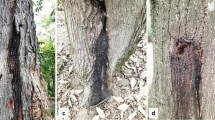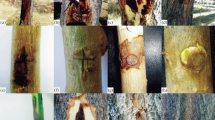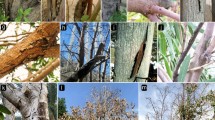Abstract
Oak decline is the most serious oak forests threat caused by a combination of biotic and abiotic factors in the world. In a survey on oak decline, 57 Biscogniauxia isolates were obtained from infected twigs and trunks of oak trees showing decline symptoms in Zagros forests, west of Iran. Based on morphology, cultural characteristics and DNA sequences data (ITS region and part of the β-tubulin gene) isolates were characterized as Biscogniauxia rosacearum and Obolarina persica. Most of the isolates belonged to B. rosacearum (40 isolates/70%). Pathogenicity test of B. rosacearum and O. persica on 2-year-old potted healthy oak seedlings confirmed the pathogenicity of both species on Quercus brantii. We report B. rosacearum for the first time on Q. brantii, Q. infectoria and Q. libani in the world. Furthermore, O. persica is reported for the first time on Q. libani and from West Azarbaijan Province. Based on the phylogenetic analyses, four species in two genera Camillea (C. obularia and C. tinctor) and Obolarina (O. dryophila and O. persica) are transferred to the genus Biscogniauxia Kuntze and two new combinations Biscogniauxia tinctor and Biscogniauxia persica are introduced.








Similar content being viewed by others
References
Abdollahzadeh J, Goltapeh EM, Javadi A, Shams-Bakhsh M, Zare R, Phillips AJL (2009) Barriopsis iraniana and Phaeobotryon cupressi: two new species of the Botryosphaeriaceae from trees in Iran. Persoonia 23:1–8. https://doi.org/10.3767/003158509X467552
Abdollahzadeh J, Zolfaghari S (2014) Efficiency of rep-PCR fingerprinting as a useful technique for molecular typing of plant pathogenic fungal species: Botryosphaeriaceae species as a case study. FEMS Microbiol Lett 361(2):144–157. https://doi.org/10.1111/1574-6968.12624
Alibakhshi S, Hovi A, Rautiainen M (2019) Temporal dynamics of albedo and climate in the sparse forests of Zagros. Sci Total Environ 663:596–609. https://doi.org/10.1016/j.scitotenv.2019.01.253
Alidadi A, Kowsari M, Javan-Nikkhah M, Jouzani GS, Rastaghi ME (2019) New pathogenic and endophytic fungal species associated with Persian oak in Iran. Eur J Plant Pathol 155(3):1017–1032. https://doi.org/10.1071/DN09035
Alves A, Phillips AJ, Henriques I, Correia A (2007) Rapid differentiation of species of Botryosphaeriaceae by PCR fingerprinting. Microbiol Res 158(2):112–121. https://doi.org/10.1016/j.resmic.2006.10.003
Bahmani Z, Abdollahzadeh J, Amini J, Evidente A (2021) Biscogniauxia rosacearum the charcoal canker agent as a pathogen associated with grapevine trunk diseases in Zagros region of Iran. Sci Rep 11:14098. https://doi.org/10.1038/s41598-021-93630-w
Bashiri S, Abdollahzadeh J, Lecce RD, Alioto D, Gorecki M, Pescitelli G, Masi M, Evidente A (2020) Rabenchromenone and rabenzophenone, phytotoxic tetrasubstituted chromenone and hexasubstituted benzophenone constituents produced by the oak-decline-associated fungus Fimetariella rabenhorstii. J Nat Prod 83:447–452. https://doi.org/10.1021/acs.jnatprod.9b01017
Cimmino A, Maddau L, Masi M, Evidente M, Linaldeddu BT, Evidente A (2016) Further secondary metabolites produced by Diplodia corticola, a fungal pathogen involved in cork oak decline. Tetrahedron 72:6788–6793. https://doi.org/10.1016/j.tet.2016.09.008
Crous PW, Gams W, Stalpers JA, Robert V, Stegehuis G (2004) MycoBank: an online initiative to launch mycology into the 21st century. Stud Mycol 50:19–22
Di Lecce R, Bashiri S, Masi M, Alioto D, Tuzi A, Abdollahzadeh J, Evidente A (2020) Phytotoxic metabolites from Stilbocrea macrostoma, a fungal pathogen of Quercus brantii in Iran. Nat Prod Res. https://doi.org/10.1080/14786419.2020.1797731
Evidente A, Maddau L, Spanu E, Franceschini A, Lazzaroni S, Motta A (2003) Diplopyrone, a new phytotoxic tetrahydropyranpyran2-one produced by Diplodia mutila, a fungus pathogen of cork oak. J Nat Prod 66:313–315. https://doi.org/10.1021/np020367c
Evidente A, Andolfi A, Maddau L, Franceschini A, Marras F (2005) Biscopyran, a phytotoxic hexasubstituted pyranopyran produced by Biscogniauxia mediterranea, a fungus pathogen of cork oak. J Nat Prod 68:568–571. https://doi.org/10.1021/np049621m
Farr DF, Rossman AY (2021) Fungal databases, U.S. National Fungus Collections. ARS, USDA. http://nt.ars-grin.gov/fungaldatabases. Accessed 16 Sep 2021
Frodin DG, Govaerts R (1998) World checklist and bibliography of Fagales (Betulaceae. Kew Publishing, Corylaceae, Fagaceae and Ticodendraceae)
Ghanbary E, Tabari Kouchaksaraei M, Mirabolfathy M, Modarres Sanavi SA, Rahaie M (2017) Growth and physiological responses of Quercus brantii seedlings inoculated with Biscogniauxia mediterranea and Obolarina persica under drought stress. For Pathol 47(5):12353–12364. https://doi.org/10.1111/efp.12353
Ghanbary E, Fathizadeh O, Pazhouhan I, Zarafshar M, Tabari M, Jafarnia S, Parad GA, Bader MKF (2021) Drought and pathogen effects on survival, leaf physiology, oxidative damage, and defense in two middle eastern oak species. Forests 12(2):247. https://doi.org/10.3390/f12020247
Ghasemi-Esfahlan S, Arzanlou M, Babai-Ahari A (2016) Detection of Biscogniauxia mediterranea, the causal agent of charcoal rot disease on oak trees in Arasbaran forests and evaluation of its pathogenicity on oak under glasshouse conditions. Iran J Plant Pathol 52(2):217–230
Ghasemi-Esfahlan S, Arzanlou M, Tavakoli M (2017) Detection of Biscogniauxia mediterranea, one of the causal agents of oak decline in Sardasht (West Azarbaijan Province). Iran J Plant Pathol 53(3):349–351
Ghobari H, Goldansaz SH, Askari H, Ashouri A, Kharazi Pakdel A, Bihamta MR (2007) Investigation of presence, distribution and flight period of oak leaf roller moth, Tortrix viridana (Lep.: Tortricidae) using pheromone traps in Kurdistan Province. J Entomol Soc Iran 27(1):47–59
Glass NL, Donaldson GC (1995) Development of primer sets designed for use with the PCR to amplify conserved genes from filamentous ascomycetes. Appl Environ Microbiol 61:1323–1330
Hall T (2004) BioEdit version 7.0.0. Department of Microbiology, North Carolina State University
Hawksworth DL, Crous PW, Redhead SA et al (2011) The Amsterdam declaration on fungal nomenclature. IMA Fungus 2(1):105–111
Hildebrand EM (1938) Techniques for the isolation of single microorganisms. Bot Rev 4:627–664
Huelsenbeck JP, Ronquist F (2001) MRBAYES: Bayesian inference of phylogenetic trees. Bioinformatics 17(8):754–755
Jazirehi M, Ebrahimi-Rostaghi M (2003) Silviculture in Zagros. Tehran University Press
Khalyani JH, Namiranian M, Heshmatol Vaezin SM, Feghhi J (2014) Development and evaluation of local communities incentive programs for improving the traditional forest management: A case study of Northern Zagros forests. Iran J for Res 25:205–210. https://doi.org/10.1007/s11676-013-0399-9
Kimura M (1980) A simple method for estimating evolutionary rate of base substitution through comparative studies of nucleotide sequences. J Mol Evol 16:111–120
Masi M, Bashiri S, Cimmino A, Bahmani Z, Abdollahzadeh J, Evidente A (2021) Phytotoxins produced by two Biscogniauxia rosacearum strains, causal agents of grapevine trunk diseases, and charcoal canker of oak trees in Iran. Toxins 13(11):812–823. https://doi.org/10.3390/toxins13110812
Masi M, Maddau L, Linaldeddu BT, Cimmino A, D’Amico W, Scanu B, Evidente M, Tuzi A, Evidente A (2016) Bioactive secondary metabolites produced by the oak pathogen Diplodia corticola. J Agric Food Chem 64:217–225. https://doi.org/10.1021/acs.jafc.5b05170
Mirabolfathy M, Groenewald JZ, Crous PW (2011) The occurrence of charcoal disease caused by Biscogniauxia mediterranea on chestnut-leaved oak (Quercus castaneifolia) in the Golestan forests of Iran. Plant Dis 95(7):876. https://doi.org/10.1094/PDIS-03-11-0153
Mirabolfathy M (2013) Outbreak of charcoal disease on Quercus spp. and Zelkova carpinifolia trees in forests of Zagros and Alborz mountains in Iran. Iran J Plant Pathol 49:77–79
Mirabolfathy M, Ju YM, Hsieh HM, Rogers JD (2013) Obolarina persica sp. nov., associated with dying Quercus in Iran. Mycoscience 54(5):315–320. https://doi.org/10.1016/j.myc.2012.11.003
Nakamura T, Supratman U, Harneti D, Maharani R, Koseki T, Shiono Y (2020) New compounds from Japanese oak wilt disease-associated fungus Raffaelea quercivora. Nat Prod Res. https://doi.org/10.1080/14786419.2020.1753054
O’Donnell K, Cigelnik E (1997) Two divergent intragenomic rDNA ITS2 types within a monophyletic lineage of the fungus Fusarium are nonorthologous. Mol Phylogenet Evol 7:103–116. https://doi.org/10.1006/mpev.1996.0376
Pourhashemi M, Sadeghi SMM (2020) A review on ecological causes of oak decline phenomenon in forests of Iran. Ecol Iran for 8(16):148–164
Raeder U, Broda P (1985) Rapid preparation of DNA from filamentous fungi. Lett Appl Microbiol 1(1):17–20. https://doi.org/10.1111/j.1472-765X.1985.tb01479.x
Raimondo ML, Lops F, Carlucci A (2016) Charcoal canker of pear, plum, and quince trees caused by Biscogniauxia rosacearum sp. nov. in Southern Italy. Plant Dis 100:1813–1822. https://doi.org/10.1094/PDIS-09-15-1037-RE
Ronquist F, Huelsenbeck JP (2003) MrBayes 3: Bayesian phylogenetic inference under mixed models. Bioinformatics 19(12):1572–1574. https://doi.org/10.1093/bioinformatics/btg180
Rostamian M, Kavosi MR, Bazgir E, Babanejad M (2017) The relationship between oak charcoal disease (Biscogniauxia mediterranea) and borer beetles in the Zagros forests. Khorramabad for Res Dev 24(3):127–142
Safaee D (2017) Identification and study on some aspects of pathogenicity and biology of xylariaceous fungi involved in oak decline in western Iran. Dissertation, University of Guilan
Safaee D, Khodaparast SA, Mirabolfathy M, Mousanejad S (2017) A multiplex PCR-based technique for identification of Biscogniauxia mediterranea and Obolarina persica causing charcoal disease of oak trees in Zagros forests. For Pathol 47(3):12330. https://doi.org/10.1111/efp.12330
Sagheb-Talebi K, Pourhashemi M, Sajedi T (2014) Forests of Iran: a treasure from the past, a hope for the future. Springer
Sagheb-Talebi Kh (2005) Rehabilitation of temperate forests in Iran. In: Stanturf JA, Madsen P (eds) Restoration of boreal and temperate forests. CRC Press, pp 397–407
Shiravand H, Hosseini SA (2020) A new evaluation of the influence of climate change on Zagros oak forest dieback in Iran. Theor Appl Climatol 141:685–697. https://doi.org/10.1007/s00704-020-03226-z
Swofford DL (2003) PAUP*: phylogenetic analysis using parsimony (*and other methods). Version 4.0b10. Sunderland, Massachusetts: Sinauer Associates
Thompson JD, Gibson TJ, Plewniak F, Jeanmougin F, Higgins DG (1997) The ClustalX windows interface: flexible strategies for multiple sequence alignment aided by quality analysis tools. Nucleic Acids Res 25:4876–4882. https://doi.org/10.1093/nar/25.24.4876
White TJ, Bruns T, Lee S, Taylor J (1990) Amplification and direct sequencing of fungal ribosomal RNA genes for phylogenetics. In: Innis MA, Gelfand DH, Sninsky JJ, White TJ (eds) PCR protocols: a guide to methods and applications. Academic Press, New York, pp 315–322
Xu D, Xue M, Shen Z, Jia X, Hou X, Lai D, Zhou L (2021) Phytotoxic Secondary Metabolites from Fungi Toxins 13(4):261. https://doi.org/10.3390/toxins13040261
Yangui I, Ben Jamaâ ML, Zouaoui Boutiti M, Vettraino AM, Vannini A, Messaoud C (2021) Occurrence of Biscogniauxia mediterranea in cork oak stands in Tunisia. Phytoparasitica 49(1):131–141. https://doi.org/10.1007/s12600-020-00872-x
Acknowledgements
Dr. B. Bahramnejad, Department of Agronomy, University of Kurdistan gave advice on statistical analyses.
Funding
This research was funded by the University of Kurdistan, Sanandaj, Iran.
Author information
Authors and Affiliations
Corresponding author
Ethics declarations
Ethics approval
Not applicable.
Informed consent
Informed consent was obtained from each individual participants included in the study.
Consent for publication
Not applicable.
Conflicts of interest
The authors have no conflicts of interest to declare.
Additional information
Publisher's Note
Springer Nature remains neutral with regard to jurisdictional claims in published maps and institutional affiliations.
Rights and permissions
About this article
Cite this article
Bashiri, S., Abdollahzadeh, J. & Evidente, A. Diagnosing and pathogenicity of Biscogniauxia species, the causal agents of oak charcoal canker and decline in Zagros forests of Iran. J Plant Pathol 104, 1011–1025 (2022). https://doi.org/10.1007/s42161-022-01124-z
Received:
Accepted:
Published:
Issue Date:
DOI: https://doi.org/10.1007/s42161-022-01124-z




